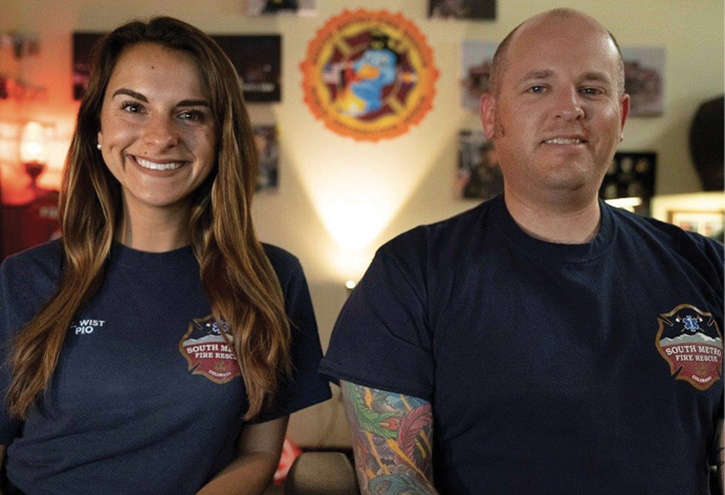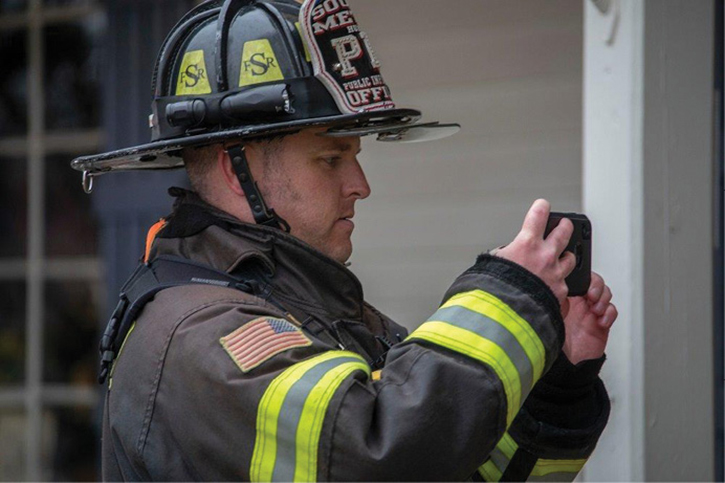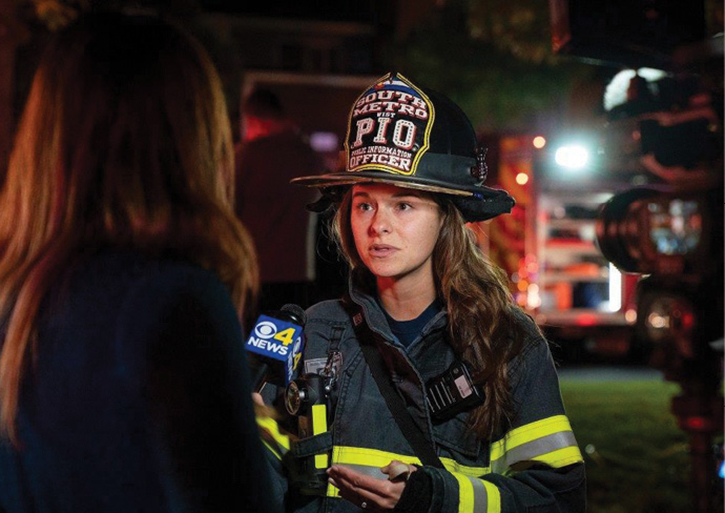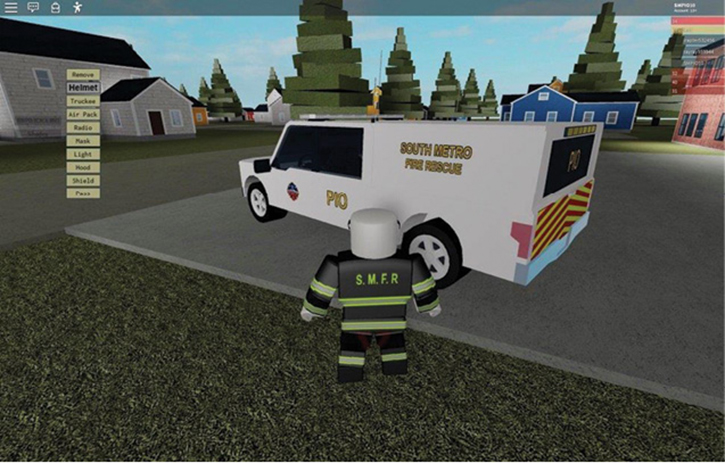
It took just six months to create the most watched fire department YouTube channel in the world. My partner Connor’s first week on the job in the Public Information Office concluded with our filming our first “vlog” (video blog) and uploading it to YouTube. Little did we know how clicking the “Publish” button that day would change our lives and increase our fire department’s popularity so dramatically. The Public Information Office’s tool compartment is brimming with social media platforms that we can use to increase community outreach, education, and recruitment, and YouTube has become our set of irons.
RELATED FIREFIGHTER TRAINING
Social Media: The Offensive Strategy
Social Media: Tell Your Story; People Want to Hear It
Hootsuite reports that every month, nearly two billion logged-in users visit YouTube. For perspective, that’s half of the Internet, and they watch one billion hours of video every day. Cisco predicts that video will account for 82 percent of all Internet traffic in the next two years. According to Nielsen, more American 18- to 34-year-olds watch YouTube than any television network. The Manifest 2019 Social Media Survey found that most of all generations use YouTube at least once a week; that includes 68 percent of Generation X and 52 percent of Baby Boomers.

(1) Connor and I pose on the “PIO Vlog” set that features a low-budget lighting and audio setup in a shared office. It’s important to remember that vlogging is looking at and talking directly to followers, not just recording a video. (Photos courtesy of author.)
The YouTube Advantage
YouTube is not Facebook. In my observations, Facebook is where most fire departments spend their social media energy. It’s a comfortable environment for most social media managers, especially those who are task-saturated with other responsibilities. Facebook requires very little strategy to gain followers and, statistically, has been the most popular social media destination. In familiar terms, however, the personal alert safety system alarm is starting to sound: According to Edison Research, Facebook has lost 15 million users since 2017.
Many fire departments already have YouTube channels; from what I’ve found, they’re commonly used as an old film dumping ground in the world’s largest public video storage facility. Although free video storage is certainly convenient, if that’s the only reason your department’s channel exists, you’re doing it wrong. There are countless internal chief messages, after-action reviews, and training videos that you should set as “Unlisted” (or “Private” if you don’t want the public to watch).

(2) I capture 4K video with my iPhone at a major incident. Breaking news video is uploaded to Twitter from the scene and later used in the vlog. In most cases, a department-issued smartphone captures sufficient video quality for YouTube and TV news.
Some fire departments are using YouTube the way it was designed, creating content specifically for public view and interaction including risk reduction education, messages to the community, fire service training techniques, after-action reviews, and the occasional raw incident video. These are all good things, but are they worth your return-on-time investment? The easiest way to measure video success is by watching the number of likes and channel subscribers. If you’re creating and publishing regular content but are not seeing significant gains, something isn’t working.
On February 11, 2019, my fellow South Metro Fire Rescue (SMFR) PIO Connor and I posted “South Metro Vlog 1.” In the 13 months that followed, our channel received 8.2 million views from people who watched more than 729,000 minutes of our video content, and our channel gained 56,000 subscribers, a 933 percent increase. On average, our channel gained 153 new subscribers every single day. Building the most followed fire department channel on YouTube didn’t happen by accident; I knew we needed to upload videos more frequently, but I wasn’t sure what to create.
Our Vlogs
If you’re unfamiliar with the term, a vlog is a regularly shared short video updating viewers on recent events. YouTube is full of travel, adventure, technology reviews, and life vlogs, but there’s only one official fire department vlog: ours! The idea wasn’t original; it was the result of an epiphany I experienced when I was exploring the Miami (FL) Police Department (MPD) YouTube channel. Its most popular video—with millions of views—is a ride-along day with Miami-Dade Fire Rescue. That’s right, the cops got more views on their firefighter video than any law enforcement content they’ve produced; that was my “aha” moment.
I knew a fire vlog was the key to SMFR’s YouTube success, but being first isn’t always easy. Despite the edgy nature of an official vlog, public information officer (PIO) hosts, the chief, and our communications director were supportive of the idea. The strategy I presented combines authenticity and transparency to inspire the next generation of job-seeking candidates to test with our department, encourage firefighters from across the globe to consider working here, provide lessons learned to improve the fire service, and promote community education and interaction with us.

(3) Connor provides a news interview at the scene of a fatal second-alarm apartment fire. Although social media allows PIOs to control the flow of information, we cannot neglect the vital relationship we have with journalists. This, too, will be in the vlog.
The first question from the boss was, “Is a vlog sustainable?” We jumped in headfirst with the goal of creating a new video each week and, so far, it has been sustainable. We have several video formats and playlists to keep viewers interested, and that helps us balance our workload. The vlog is a biweekly update featuring major incidents and training that occurred over the past seven days. We provide PIO commentary packaged with on-scene video and radio traffic. Most of this content is easy to stitch together since we respond to all working incidents and already capture photos and video. Most of the breaking real-time news coverage we provide on Twitter will end up in the vlog later. The vlog usually requires minimal planning; it’s enjoyable to create, and it continues to grow our fire department’s social media following.
The second question was, “What does this cost?” As with almost everything, the more time and money with which you can supply a project, the better it will be. Vlogging is no different, but it can be achieved quite easily on a low budget. A YouTube account is free, and the video your smartphone captures is likely suitable. A video editing app or software is a necessity and ranges from $15 to $300, depending on the capabilities. Good audio is almost as important as good video. You can do audio correction in editing software, but an external microphone is ideal. A decent mic runs between $50 and $100. A small tripod or camera grip and an LED light are nice to have, too.
We also asked ourselves how we would balance information and entertainment. Obviously, we need to create an environment where people want to be with us, and it can’t be serious all the time. But, as PIOs, we also discuss dangerous situations that result in the loss of lives and property, and there’s no room for humor. We maintain a delicate balance; to date, no one has questioned our demeanor. Our audience is with us through fun times and tragic incidents such as the STEM School Shooting on May 7, 2019. Simply, we’re honest with them.
Our most popular vlog to date was filmed during the “bomb cyclone” blizzard that hit Colorado. I’ve said it before, and I’ll say it again: PIOs need to be where the story is happening. On that day, I was. Instead of a cozy snow day at home in front of the fireplace, I jumped on a busy engine company and captured video as the SMFR ran calls in the blinding snowstorm. I provided real-time video updates on Twitter that ended up as national news when the firefighters I was with freed a stuck police cruiser from the snow. The next day, I uploaded video from the entire shift with narration to YouTube and shared it across our social media channels for our residents to watch and appreciate the difficult work that our firefighters do for the community. All of this, except for one creative shot with a GoPro attached to a bay door, was done with my iPhone.
“Fleet Friday” is another MPD original video that our subscribers not only asked to see but begged for, and we listened. Fleet Friday features a video walkaround of an apparatus while the firefighter opens each door, explaining what’s inside and how it’s used. Our goal is to provide a new Fleet Friday episode each month between vlogs. These videos receive a lot of interaction from young kids, firefighters from other agencies, and community members. Internally, personnel have commented that these videos provide great training for young members as well as a refresher on specialty apparatus for the more senior members.
In 2019, the Fire Academy series undoubtedly gained the most popularity and continues to generate the most interaction on our channel. Connor took on the task of documenting Recruit Academy 19-1 with weekly vlogs for 16 weeks. Viewers got a behind-the-scenes look at academy life. As the videos were released, subscribers say they felt personally tied to the recruits during the process and celebrated their graduation. As a result of these vlogs, we answer questions from people across the world who want to be firefighters at our department.
South Metro Unscripted is a video series that existed long before the vlogs and created a foundation for the YouTube channel. Unscripted is exactly that: an authentic story told by SMFR personnel and usually not narrated or hosted by PIOs. These videos require more planning, better cameras, more editing time, creative cinematic effects, and a longer format. The most popular Unscripted episode follows a probationary firefighter during her first shift in the firehouse after academy graduation.
The year 2020 signaled the beginning of the new monthly series A Day in the Life. In it, Connor and I follow an SMFR employee during his or her shift, capture everything on video, and edit it down to a roughly 20-minute production. This series combines community education with recruitment and has already been a huge success. A firefighter, an engineer, and a lieutenant have been featured so far, and the series has already gained one million views.
The Good and the Inconvenient
As with any uncharted territory, there have been some surprises along our YouTube journey—and most of them have been great. First, we have an absolutely amazing fan base. Since “Vlog 1,” our YouTube audience not only has helped us improve our video content through their comments and suggestions, but they overwhelmingly support us. Every week, we receive patches, challenge coins, shirts, and letters from across the world. Aspiring, current, and retired firefighters write us to share their personal stories and offer kind words of encouragement. Visitors from across the globe have made it a point to stop and visit our department while traveling. It’s something we never anticipated and greatly appreciate.
We take the good with the inconvenient. “Internet trolls” are everywhere and are not afraid to leave rude and sometimes inappropriate comments on our social media channels. Generally, the existing fan base takes care of negativity, and it doesn’t require PIO interaction. Unless there is a direct threat or question from a troll, we leave the comments alone. YouTube automatically holds comments with profane language for review and out of public view.
Keyboard incident commanders will occasionally provide their input, too. We all learn from each other, so we take comments on our videos and images seriously. That being said, it is important to remember that our viewers will see a very limited perspective of most incident scenes; thus, the audience can’t always make an accurate assessment. We have found ourselves explaining everything from why our PIOs wear personal protective equipment to why a firefighter was using a Pulaski instead of a McLeod at a grass fire. When you shine a spotlight on your agency, it will be seen, and you must be prepared to handle questions and concerns respectfully.
Influencer status is also an unexpected reality of our channel. Although, ethically, we cannot endorse or sell products, this hasn’t stopped companies from asking us to do so. Private YouTube vloggers make their living off monetizing their channel, and advertisers are spending big money for influencers to market products.
Collaboration is something most YouTubers seek, especially with likeminded creators who have a larger following. Connor and I were ecstatic when Michelle Khare asked us to collaborate on her extremely successful series Challenge Accepted. Khare takes on a variety of careers while experiencing what it takes physically, mentally, and emotionally to do them. She brings her audience of 1.83 million subscribers with her on the journey; her most popular episodes have more than six million views. We granted Khare’s request and set up the best possible firefighting experience we could. Her “I Tried Firefighter Academy” video gained 800,000 views in one month; from the more than 4,000 comments, it’s clear that her video provided great community education to a mostly younger demographic. It has also prompted more subscribers on the SMFR YouTube channel and inspired more young people to be firefighters.
Internet “Influencers”
You may be asking, “What do influencers, collaboration, and number of views have to do with the fire service?” When combined, they are the most authentic, far-reaching, cost-effective recruitment tool available. The U.S. Marine Corps and Navy are examples of government agencies using social media influencers to reach young viewers and inspire them to consider a new career opportunity. In a study conducted by Defy Media, 95 percent of Generation Z (born between 1997 and 2002) said they use YouTube, and half of them said they couldn’t live without it. According to Google, 80 percent of Generation Z teens say YouTube has helped them become more knowledgeable about something.

(4) This screenshot of the South Metro Area Roblox video game shows a simulation world with duplicate stations, apparatus, and gear. It’s a safe place where SMFR YouTube subscribers pretend to work for our fire district.
You might also be asking about the return on investment for all of our time and effort. A social media advertisement revenue calculator was used to approximate the value of the Fire Academy series, the Day in the Life series, and Khare’s “I Tried Firefighter Academy” video. This combined, organic recruitment campaign value totaled $124,743 based on the current count of views, interactions, and comments.
Generation Z is the first digitally native generation; they’ve never known a life without smartphone technology and being connected to social media. According to Adweek, 52 percent of Generation Z and half of millennials trust social media influencers more than television and movie stars or athletes. Generation Z has redefined who celebrities are, and they’re found on YouTube channels. Connor and I questioned the validity of this until young followers of the SMFR began telling their parents they know celebrities—us.
The volume of messages across our social media inboxes has increased dramatically and, as an agency, we couldn’t be happier. That interaction created an unexpected shift in our daily office responsibilities, but it’s well worth the time investment. When an Instagram follower messaged us for photos of stations, apparatus, and gear for a video game, we provided the images but didn’t take the request very seriously; we should have. Months later, the South Metro Area Roblox video game was live. I was speechless when I logged in and found a replica simulation version of our fire department complete with my PIO pickup truck. The core age group of gamers is nine to 15 years old. In their simulation world, they can dress in uniforms or bunker gear while exploring SMFR stations and driving apparatus emergent. They’re hooked!
Telling our fire department’s story every week on YouTube continues to be the best social media time investment we can make. It doesn’t replace our traditional PIO roles and responsibilities, but it has made it possible for our agency’s voice to reach a much greater audience. The trend of social media statistics should point more public safety agencies to enhance their YouTube presence.
ERIC HURST is a 22-year fire service veteran and a public information officer with South Metro (CO) Fire Rescue. He is also a social media instructor and an internationally published photographer and videographer.

